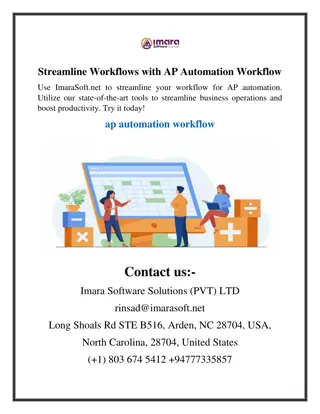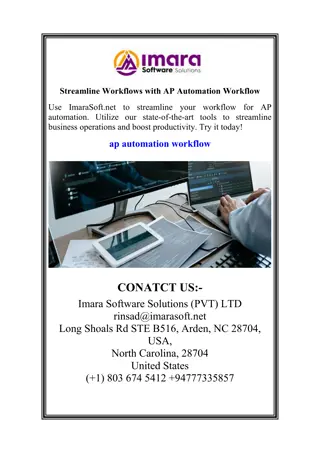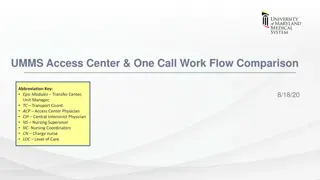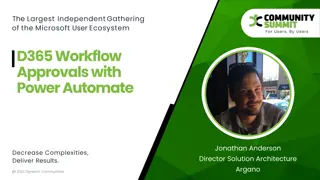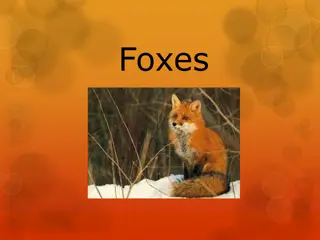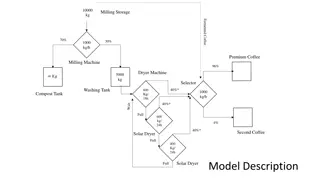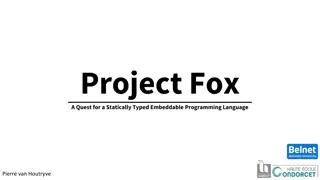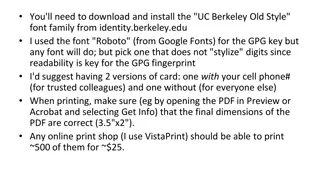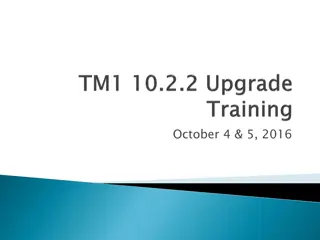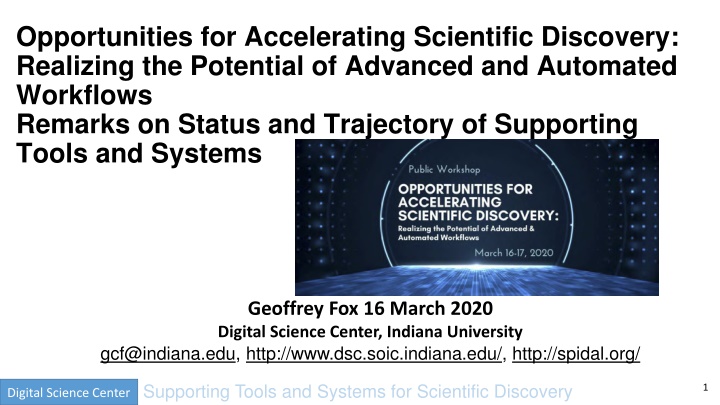
Accelerating Scientific Discovery with AI and Automation in Workflows
Explore the impact of AI-driven workflows on scientific discovery, challenges faced by automation systems, and the future vision for integrating AI in scientific workflows. Discover the potential of deep learning, the need for enhanced industry interactions, and the proposal for an MLPerf Working Group in Scientific Data benchmarking.
Uploaded on | 1 Views
Download Presentation

Please find below an Image/Link to download the presentation.
The content on the website is provided AS IS for your information and personal use only. It may not be sold, licensed, or shared on other websites without obtaining consent from the author. If you encounter any issues during the download, it is possible that the publisher has removed the file from their server.
You are allowed to download the files provided on this website for personal or commercial use, subject to the condition that they are used lawfully. All files are the property of their respective owners.
The content on the website is provided AS IS for your information and personal use only. It may not be sold, licensed, or shared on other websites without obtaining consent from the author.
E N D
Presentation Transcript
Opportunities for Accelerating Scientific Discovery: Realizing the Potential of Advanced and Automated Workflows Remarks on Status and Trajectory of Supporting Tools and Systems Geoffrey Fox 16 March 2020 Digital Science Center, Indiana University gcf@indiana.edu, http://www.dsc.soic.indiana.edu/, http://spidal.org/ Digital Science Center Supporting Tools and Systems for Scientific Discovery 1
Questions Asked What are your observations on the impact of systems and tools to automate workflows, with respect to scientific discovery? What is the role of artificial intelligence (AI) and automation in scientific discovery? We d like you to consider both AI-driven workflows as well as workflows that include AI as part of the scientific discovery process. What are the current challenges faced by these systems? What do you see as disruptors that will affect how workflow tools are being used by the scientific community? What is your vision for AI in workflows in the future of scientific discovery? What research is needed to advance this area? Digital Science Center Supporting Tools and Systems for Scientific Discovery 2
Challenges and Futures What are the challenges? AI for science very promising Deep Learning broadly used in industry; many science areas need to examine it. AI for basic cyberinfrastructure useful but modest performance increase factor of 10 or less Speedups of up to 2. 109reported for Deep Learning inside HPC applications but only in some fields and needs significant changes in application code Need middleware integrating simulations and AI inside HPC; Implications of new AI accelerators How do you see the future? Need to enhance interactions between science and industry Common software stacks in workflow, deep learning Already PyTorch and TensorFlow are used in Industry and Research But can extend with more use of Apache Big Data Software in science MLPerf Industry benchmarks can be extended to Science MLSys is perhaps a very relevant meeting with strong Industry involvement and dominant use of HPC technologies but currently very little attention from cyberinfrastructure/HPC community No attention to science applications at MLSys 2020 Bring Clouds and Supercomputers closer together Graduate students use Google Colab rather than traditional cyberinfrastructure Digital Science Center Supporting Tools and Systems for Scientific Discovery 3
Proposal for an MLPerf Working Group in Scientific Data MLPerf has 68 Industry members and academics from CS AI not Cyberinfrastructure; DoE labs strong Results on 1536 GPU s and 2048 TPU s i.e. clear HPC systems but called clouds Suggest that Science Research Data should use MLPerf (presented at March 12 MLPerf Community meet) There is no existing scientific data benchmarking activity with a similar flavor to MLPerf -- namely addressing important realistic problems aiming at modern data analytics including deep learning on modern high- performance analysis systems. Science like industry involves big data with edge and data-center issues, inference, and training, There are some similarities in the datasets and analytics as both industry and science involve image data but also differences; science data associated with learntsimulations and pandemic time series and particle physics experiments are quite different from most industry exemplars. The best practice science algorithms are shifting to deep learning approaches as in industry today. When fully contributed, the benchmark suite could include the following domains: material sciences, environmental sciences, life sciences, fusion, particle physics, astronomy, earthquake, epidemiology and earth sciences, with more than one representative problem from each of these domains Cover Accuracy and Speed. Further, the benchmarks will be exemplars of modern AI for Science Encourage fruitful comparisons and collaborations between scientific fields and industry Define requirements for future cyberinfrastructure to support scientific data analysis Target users would be quite broad: academics (including teaching), researchers, scientists and the companies and service providers building systems used by Science. Proposed working group has natural links to established MLPerf working groups including HPC and DeepTS 4 Digital Science Center Supporting Tools and Systems for Scientific Discovery
Workflow (same as Orchestration) 271 workflow systems listed at: https://github.com/common-workflow-language/common-workflow- language/wiki/Existing-Workflow-systems About 100 at the these two awesome sites: https://github.com/meirwah/awesome-workflow-engines https://github.com/pditommaso/awesome-pipeline Many are domain specific but number illustrates the choices available PyTorch and TensorFlow support a dataflow pipeline of deep learning stages Apache Beam, Spark and Flink with support of dataflow can implement workflow functions Growing link between DevOps and Execution (TOSCA and BPEL) Orchestration Exploit containers, Function as a Service, Cloud Native, Pub-Sub events Peer to Peer or Central management Digital Science Center Supporting Tools and Systems for Scientific Discovery 5
Apache Beam, Kubeflow, Argo: Typical Industry Workflow Recent Industry solution aimed at AI workflows constructed as a graph of containers March 11, 2020 https://cloud.google.com/blog/products/ai-machine-learning/introducing-cloud-ai-platform-pipelines Full edge to cloud workflow Google Cloud AI Platform Pipelines on Kubernetes General DAG connected containers Digital Science Center Supporting Tools and Systems for Scientific Discovery 6
Futures of MLforHPC I MLforHPC succesful but current use is nonuniform across domains We need to improve Cyberinfrastructure support to make MLforHPC more effective for more users Use of modest DL network to map material/potential drug structure to properties (generalized QSAR) with simulation and observation: Advanced Progress Learn surrogates for large scale simulations: initial results Use of MLforHPC in agent-based systems (learn agents replacing by surrogates): Very promising but few results Use in Sociotechnical simulations and in virtual tissues (agents are people or cells) Macroscopic structure as in learn complex multi-particle potentials scaling to N7: many great successes Learn Collective coordinates and guide ensemble computations: dramatic progress with speedups up to 108 Microscale; learn dynamics of small scale such as clouds, turbulence: Interesting results but much more to do Use of Recurrent NN s to represent dynamics (learn numerical differential operators): Promising but only studied in small problems Digital Science Center Supporting Tools and Systems for Scientific Discovery 7
Futures of MLforHPC II Learn errors as well as values in differential equation solutions Look at advanced solver methods such as fast multipole or ML learnt potentials Quantify Deep Learning for (geospatial) Time Series for different applications and different methods: Looking at Industry is Ride Hailing and Transportation as well as audio MLPerf has a Deep Learning for Time Series working group Earthquake Forecasting (are there actually hidden variables as phase transition?) Epidemic Forecasting with mix of simulation and observation Investigate different methods: RNN (LSTM, GRU), RNN-T, non-recurrent with attention: Transformer Build Software systems to support AI dynamically mixed with simulation Investigate optimized hardware CPU, Accelerator, Storage, Network for AI dynamically mixed with simulation How does this hardware and software compare to that for Edge to Cloud data-center use case Simulation supercomputer Classic data-center big data problem 8 Digital Science Center Supporting Tools and Systems for Scientific Discovery

